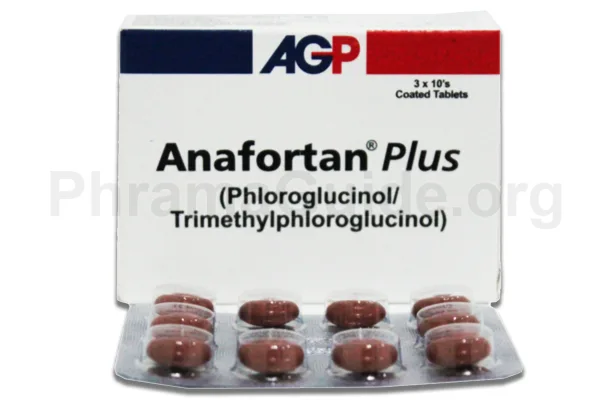Anafortan tablet is primarily used for the treatment of abdominal pain or spasms associated with gastrointestinal disorders. It helps to relax the smooth muscles in the gastrointestinal tract, thereby relieving cramps and discomfort. Following are some common and off-label uses of Anafortan Tablet:
Common Uses of Anafortan Tablet
- Spasmodic Pain Relief: Anafortan tablets are primarily used as antispasmodic agents to relieve smooth muscle spasms. The use of Anafortan Tablet can help alleviate pain and cramping associated with conditions such as irritable bowel syndrome (IBS), biliary colic, urinary tract spasms, and other gastrointestinal or genitourinary disorders.
- Gastrointestinal Disorders: Anafortan tablets are often used for the symptomatic relief of gastrointestinal disorders. Anafortan tablets can help alleviate abdominal pain, bloating, and cramping associated with functional gastrointestinal disorders, including IBS.
- Obstetrics and Gynecology: Anafortan tablets may be used in obstetrics and gynecology to relieve uterine spasms and associated pain. Using Anafortan can be helpful in conditions such as dysmenorrhea (painful menstruation) or threatened miscarriage. By relaxing the uterine muscles, Anafortan can reduce discomfort and pain.
- Diagnostic Procedures: Anafortan also can be used in conjunction with certain diagnostic procedures. They can be administered before cholangiography (imaging of the biliary tree) or cystoscopy (visualization of the urinary tract) to enhance the visualization of these areas by causing relaxation of the smooth muscles.
Off-label Uses of Anafortan Tablet
- Functional Gastrointestinal Disorders: Anafortan may also be used off-label for other functional gastrointestinal disorders such as functional dyspepsia and functional abdominal pain.
- Postoperative Abdominal Pain: Some trials have explored the use of Anafortan in reducing postoperative abdominal pain and promoting recovery after abdominal surgery.
- Pelvic Pain: Anafortan has been used off-label for the treatment of pelvic pain, including conditions such as chronic pelvic pain syndrome and endometriosis-associated pain.
- Gastroesophageal Reflux Disease (GERD): Although Anafortan is not specifically approved for the treatment of GERD, it has been used off-label in some cases to relieve symptoms such as heartburn and regurgitation.

What is Anafortan?
Anafortan is one of the leading brands of Phloroglucinol + Trimethylphloroglucinol, manufactured and marketed by AGP Pharma (Pvt) Ltd, Pakistan.
Anafortan Alternatives : Other Similar Brands
The following are some alternative brands of Anafortan and their manufacturers.
- Spasrid : Barrett Hodgson (Pvt) Ltd, Pakistan.
- Orglu : Sami Pharmaceuticals (Pvt) Ltd, Pakistan.
- Spadix : Tabros Pharmaceuticals, Pakistan.
- Spasfon : Himont Pharmaceuticals (Pvt), Pakistan.
- Helispa Plus : Helix Pharmaceuticals, Pakistan.
- Gluthyl : Mass Pharma (Pvt) Ltd, Pakistan.
- Furosinol : Century Pharmaceuticals, Pakistan.
- Spastrim : Medera Pharmaceuticals, Pakistan.
- Spasmex : Angelini Pharmaceuticals (Pvt) Ltd, Pakistan.
Anafortan : Available Formulations and Strengths
Presently, Anafortan is available in Tablet and Injection Forms with the following strengths.
Anafortan Tablet : Phloroglucinol 80mg + Trimethylphloroglucinol 80mg strengths.
Anafortan Injection : Phloroglucinol 40mg/4ml + Trimethylphloroglucinol 0.04mg/4ml strengths.
Who Should Not Use Anafortan?
Anafortan has a relatively good safety profile, but there are certain contraindications and precautions that should be considered before using Anafortan.
- Hypersensitivity: Individuals who have a known hypersensitivity or allergy to phloroglucinol, trimethylphloroglucinol, or any other components of the medication should not use Anafortan.
- Severe Liver Disease: Anafortan is primarily metabolized in the liver, so individuals with severe liver impairment or active liver disease may require dose adjustments or should avoid using these medications altogether. It is important to consult a healthcare professional in such cases.
- Intestinal Obstruction: Anafortan is contraindicated in cases of suspected or confirmed intestinal obstruction. These medications may interfere with the diagnosis of the underlying condition and are not appropriate for use in this context.
- Children Younger than 6 Years (Trimethylphloroglucinol): Trimethylphloroglucinol is an active ingredient of Anafortan and generally contraindicated in children younger than 6 years of age, as there is limited clinical data available to support its safety and efficacy in this age group.
- Pregnancy and Breastfeeding: The use of Anafortan during pregnancy and breastfeeding is generally not recommended due to limited safety data. It is important to consult with a healthcare professional for appropriate guidance and consideration of the potential risks and benefits in these situations.
What is the Recommended Daily Dosage of Anafortan?
Anafortan Dose:
- 1 to 2 tablets, 2 to 3 times daily.
Maximum Dose of Anafortan:
- 6 tablets in a day.
How Anafortan Works?
Anafortan works by possessing calcium channel-blocking. It can inhibit the influx of calcium ions into smooth muscle cells, which is necessary for muscle contraction. By blocking calcium channels, It decrease the sensitivity of smooth muscle cells to stimuli and reduces muscle contractions.

Leave A Comment